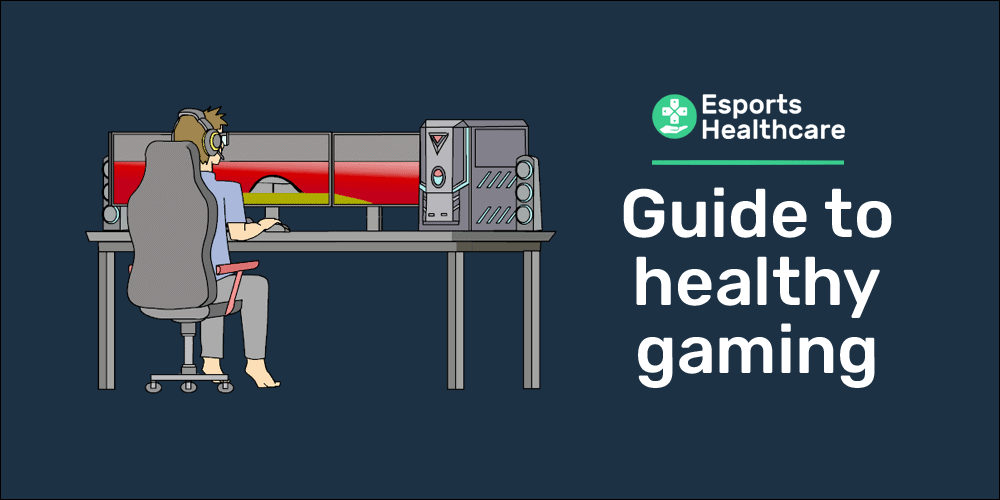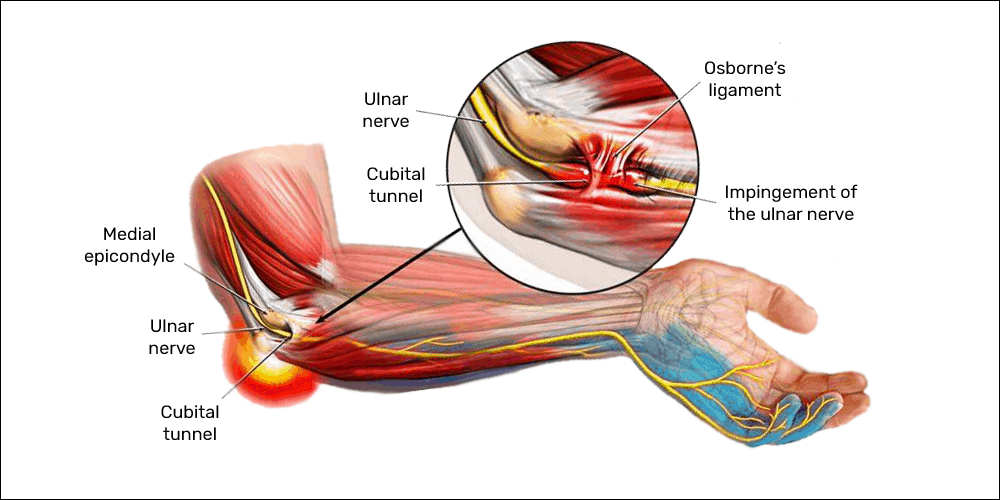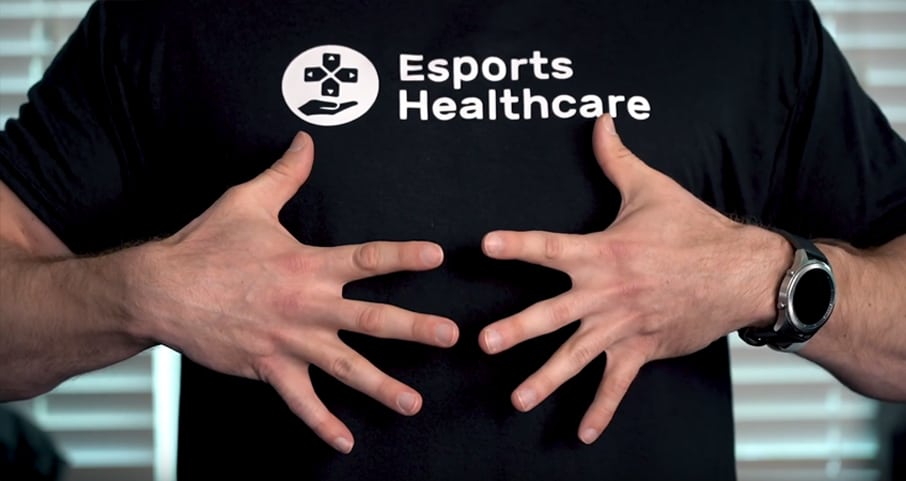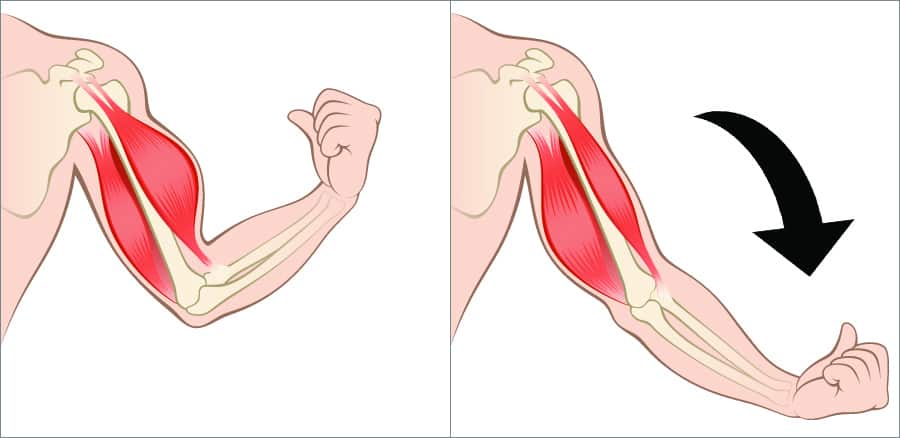The ultimate guide to healthy gaming

Key points
Disclaimer
This information is for educational purposes only and is not intended to replace the advice of your doctor. Esports Healthcare disclaims any liability for the decisions you make based on this information.
The information contained on this website does not establish, nor does it imply, doctor-patient relationship. Esports Healthcare does not offer this information for diagnostic purposes. A diagnosis must not be assumed based on the information provided.
You’re a gamer, and the grind is constant. You’re playing for your stream or to continue to improve your skill. You’re going at it alone or practicing with your team. Regardless, you’re gaming a lot.
The gaming grind is taxing, and the long hours increase the strain on your body from prolonged sitting and repetitive movements. Fortunately, we’re here to help you get through the grind and decrease your risk for aches, pains, and injuries with this guide to healthy gaming.
Warm-up
Many people still believe warm-ups include static stretching (or stretch and hold positions) to “get loose” before doing any type of physical activity. However, static stretching will decrease your performance.
That’s right—holding stretches prior to (or even during) gaming may decrease muscle activation and contractile velocity making you slower.
Latency for any reason is a nightmare, but the good news is that you can prevent movement latency simply by following a dynamic warm-up routine.
Our gamer warm-up is a routine consisting of dynamic movements that prepare your body for healthy gaming—specifically, your fingers, hands, wrists, forearms, and even your eyes!
There are 10 movements to warm up your hands and 3 eye movements to warm up the small muscles that control your eyes.
Posture and ergonomics
Gaming for hours means sitting for hours, and sitting increases your risk for postural aches and pains. Prolonged sitting over time increases your risk for muscular imbalance and joint degeneration of the hips, spine, and shoulders.

However, your posture is the foundation of healthy gaming, and you can effectively reduce the risk for all these issues by correcting your posture—sitting upright and not leaning forward, keeping your shoulders back and down, and keeping your head back with your chin tucked.
- Posture is how you carry your body while sitting or standing
- Ergonomics has more to do with comfort and efficiency while working
You’ve probably noticed advertisements for products like gamer chairs and desks bragging about their “unique, ergonomic design.”
Following ergonomic design, it is important to set the arms of your gamer chair just high enough to let your forearms rest gently when your arms are resting at your side and your elbows are bent 90 degrees.
An alternative is to rest your forearms on your thighs or computer desk. Either way, do not compromise your posture by leaning forward!
It is also incredibly important to ensure there is no pressure on the inside of your elbow (or the inside of your forearm just below the elbow)—think funny bone.
This region is where the ulnar nerve travels, and pressure in this area may cause cubital tunnel syndrome—a nerve impingement that causes pain, numbness, tingling, and/or weakness in the pinky side of the forearm, hand, and ring/pinky fingers.

Healthy gaming includes taking breaks!
One great way to prevent injury, aches, and pains is to take breaks and perform antagonist movements; in other words, do the opposite of what you do while gaming. For example, you sit still when you game—so stand up and move on your breaks. Below is a list of antagonist movements to appropriately break apart your grind.
Also, remember that static stretching reduces performance! Holding a stretch will make your muscles slower which can negatively affect your gameplay. If you feel like your muscles are tight after a game, try these tips instead of stretching your muscles and thereby decreasing your movement speed.
Every 15-20 minutes, perform these actions
While gaming: your eyes only focus on the monitor approximately 20-24 inches from your face.
Take a break: look beyond your monitor (at least 20 feet) and look all around with just your eyes. Focus on different objects away from you and around you while you perform the rest of this list.
While gaming: you’re sitting still.
Take a break: stand up and move around—any way you choose. You don’t even need to walk away from the setup; for example, simply stand up and shuffle your feet!
While gaming: your head and neck don’t move, or they move very little.
Take a break: nod your head all the way back-and-forth 3 times, turn your head all the way left-to-right 3 times, and side bend your neck all the way back-and-forth 3 times.
While gaming: you won’t blink much—sometimes not at all.
Take a break: blink! Blink your eyes firmly 5-10 times between games to make sure your eyes won’t dry out and begin to burn.
Another movement that is helpful to relieve postural tension is called Bruegger’s position:
- Stand upright and tuck your chin back (shift your head over your shoulders without tilting your head back).
- With your hands at your sides, turn your palms to face forward.
- Pull your shoulder blades back towards each other and pull them downward (depress your shoulders instead of shrugging).
- Hold this position for 3-5 seconds and relax
- Repeat this movement 3-5 times.
Remember to look all around. If you have some extra time, this is an opportunity to perform the three eye exercises from the gamer warm-up.
And remember, DO NOT STATIC STRETCH!

Specific to PC gamers
While gaming: your hands and fingers perform extension more often than flexion while lifting your fingers off the keyboard and mouse.
Take a break: make a fist and flex your wrists—palms towards your forearm. Open your hand gently; do not forcefully open your hand into wide extension. Repeat this movement 5-10 times.
Specific to console gamers
While gaming: your thumbs are pressing downward to move the joysticks and press the joystick buttons (to aim, crouch, melee, etc.).
Take a break: extend your thumbs; think of exaggerating a thumbs-up motion. Between each thumbs-up, relax your thumb. Do not squeeze or press it back down. Repeat this movement 5-10 times.
While gaming: you’re gripping a controller and flexing (closing) your fingers down onto the triggers or paddles if you use them.
Take a break: turn your palms up, open your hands as wide as you can, and then relax; do not close your fist again. Repeat this movement 5-10 times.
While gaming: if you use the claw technique, read through this page!
Take a break: press your palms and fingers together. Separate your index fingers as far as you can, then return to the center. Repeat this movement 10 times (see “Palms together, single finger extension” on the gamer warm-up, pictured below).

Healthy gaming snacks
Snacking is not the healthiest of habits. Ingesting small meals numerous times increases your insulin frequently which can lead to many health issues. However, snacking is difficult to avoid while gaming. So, we’ve compiled a list of 7 healthy gaming snacks for you to enjoy while simultaneously maintaining your health.
The day is over—now is the time to stretch
So, you’re finally done gaming. You’ve completed the day, and you won’t be gaming again until tomorrow or later. Now is the time for static stretching. Our gamer stretch routine was created to assist in the prevention of aches, pains, and injuries that gamers may face.
Following physical activity, stretching may increase range of motion and release chronic tension in muscles. Only perform static stretching when you’re done with gaming so you don’t negatively affect your performance.
There are 7 stretches included for the muscles of your fingers, hands, and wrists. Stretching at the right time is a staple of healthy gaming.
The gaming grind should NOT be painful
Many of the aches, pains, and ailments experienced by gamers are in the category of repetitive strain injuries. The name suggests these issues are simply caused by doing something too frequently, but that’s not the case. Repetitive strain injuries occur due to an imbalance, and this imbalance occurs in two ways.
Agonist vs. antagonist imbalance
PC gaming
The position of the hands will be neutral or into extension, and the more forceful movements performed in PC gaming are also in extension—lifting the fingers off the keyboard or mouse.
The position of the hands and fingers on the mouse and keyboard does not allow for significant flexion of the fingers or wrists.
Console gaming
Nearly every movement in console gaming includes flexion of the hand and fingers—think closing your hand or making a fist.
Console gamers flex their thumbs onto the joysticks, flex their fingers onto triggers and bumpers, and flex their fingers to grip the controller. There is no significant extension or opening of the fingers or hand when playing with a console controller.
Shortening vs. lengthening imbalance
There are 2 major phases of muscle contraction during exercise or other intense physical activity. Concentric contraction is the shortening of a muscle against resistance (think of raising the weight on any dumbbell or barbell exercise).
Eccentric contraction is the lengthening of a muscle against resistance (think of lowering the weight on any dumbbell or barbell exercise).

In gaming—both PC and console—the muscles of the fingers, hands, and wrists are never worked in eccentric contraction. Performing our injury prevention exercises and our stretch routine after gaming may counter the effects of repetitive muscle shortening during console gaming and help prevent these injuries.
Gaming should never be painful—even when you’re on your most intense grind and the hours are piling up. Following the steps in this post may effectively decrease your risk for many of the common ailments in gaming.
Lifestyle habits for healthy gaming
Healthy gaming extends beyond the grind. The steps, so far, are to maintain your health while you’re gaming. These next few steps are to help you maintain your health while you’re not gaming.
Stay hydrated
Fluid intake and absorption are one of the most important aspects of general health, and therefore healthy gaming. The simple rule for hydration is to consume half your body weight (in pounds) in ounces of fluid.
For example, if you weigh 140 pounds, drink 70 ounces of fluid. This fluid is not limited to water. If you drink 8 ounces of coffee, for example, that’s 8 ounces towards your cumulative total. Of course, we recommend drinking water as the vast majority of your fluid intake for optimal health.
Prioritize your sleep
Sleep is arguably the most important aspect of your health & well-being. There is not one single thing more beneficial than healthy sleep habits. For healthy gaming and healthy living, we recommend 8 hours per night, every night, no questions.
Learn about healthy foods
We’ve been adding nutrition content as often as we’re able. So far, you can learn the basics of nutrition, learn how to read nutrition labels, and learn about 7 snacks that will help maintain your health. Continue to check back on our nutrition home page to keep up with our new posts!
